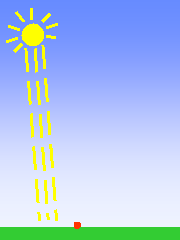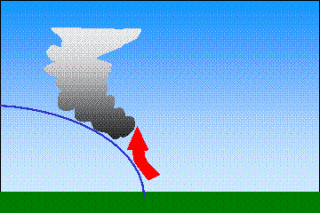|
|
 |
|
|
|
 |
| |
|
|
 |
Clouds & Particles
Basics |
Formation of clouds
A cloud is composed of millions of little droplets of water or ice crystals, when temperature is very low, suspended in the air. Clouds can form when water vapor becomes liquid, i.e. when humid air is cooled the water vapour condenses onto tiny particles. We now look at the major ways in which clouds form.
|
|
|
|
|
 |
 |
 |
|
1. Formation of clouds by convection process.
Author: J. Gourdeau.
|
|
 |
Convection
On Earth, the density of air depends on its temperature. This means that warm air rises and cold air sinks because warm air is less dense than cold air. This movement of warm air upwards is known as convection. Convection is one of the processes that allows clouds to form. The Sun warms the surface of the Earth. This warmth heats the humid air at the ground and, as a result, the air becomes less dense and begins to rise. As the air rises, it cools. Clouds are formed when the humid air cools below a critical temperature: the water then condenses onto tiny suspended particles and forms water droplets in the air.
|
Topography (mountains)
Clouds also form over mountains or hills. These clouds are called orographic clouds. The air is forced to rise over the mountain and, as it rises, it cools. If the air cools to its saturation point, the water vapour condenses and the water contained within the air becomes visible as a cloud.
|
 |
 |
2. Source: NOAA |
|
 |
 |
 |
3. Source: NASA |
|
The Foehn effect
When air rises over the mountains, it cools and becomes saturated with water vapour. Condensation occurs and the water vapour becomes liquid. This liquid water stays as clouds or falls as rain as the air continues to rise. When this air descends on the other side of the mountain it contains less water so it is warmer and dryer. The difference in temperature from one side of a mountain to the other is known as the Foehn effect.
|
When different air masses meet
It's not only mountains which force air to rise. When warm air meets a mass of heavier cold air, the warm air is forced to rise. The boundary between warm and colder air is called a front. As the warm air rises it cools and as it cools clouds may form.
|
 |
 |
4. Cold front. A: cold air; B: warm air. Here cold air moves towards a warm air mass and forces the warm air to rise. Author: J. Gourdeau. |
|
 |
 |
 |
5. Warm front. A: cold air; B: warm air. Here warm air moves towards a mass of cold air and rises. Author: J. Gourdeau. |
|
Horizontal motion
Sometimes winds bring warm and moist air into a region. If the warm moist air moves over a much colder surface, it is cooled and the moisture it contains will condense and form fog. This process occurs frequently at the coast.
|
 |
 |
 |
|
6. Fog over a lake. Source: Ph. Osset
|
|
About this page
author: Dr. Justine Gourdeau - LaMP, Clermont-Ferrand, France
scientific reviewer: Prof. A. Flossman - LaMP, Clermont-Ferrand, France
published: 2003-03-12
|
|
 |
|







